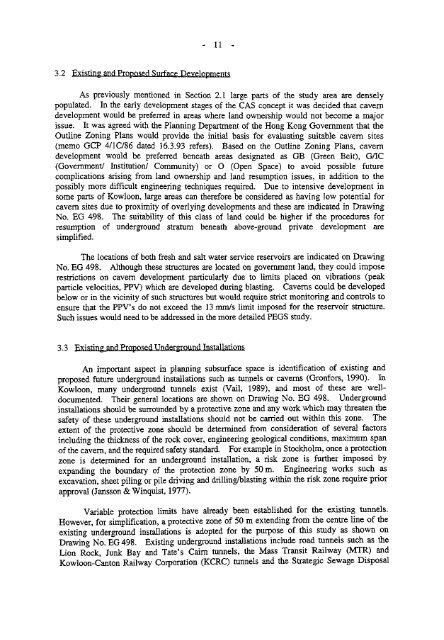miscellaneous planning standards and guidelines - HKU Libraries
miscellaneous planning standards and guidelines - HKU Libraries
miscellaneous planning standards and guidelines - HKU Libraries
Create successful ePaper yourself
Turn your PDF publications into a flip-book with our unique Google optimized e-Paper software.
113.2 Existing <strong>and</strong> Proposed Surface DevelopmentsAs previously mentioned in Section 2.1 large parts of the study area are denselypopulated. In the early development stages of the CAS concept it was decided that caverndevelopment would be preferred in areas where l<strong>and</strong> ownership would not become a majorissue. It was agreed with the Planning Department of the Hong Kong Government that theOutline Zoning Plans would provide the initial basis for evaluating suitable cavern sites(memo GCP 4/1C/86 dated 16.3.93 refers). Based on the Outline Zoning Plans, caverndevelopment would be preferred beneath areas designated as GB (Green Belt), G/IC(Government/ Institution/ Community) or O (Open Space) to avoid possible futurecomplications arising from l<strong>and</strong> ownership <strong>and</strong> l<strong>and</strong> resumption issues, in addition to thepossibly more difficult engineering techniques required. Due to intensive development insome parts of Kowloon, large areas can therefore be considered as having low potential forcavern sites due to proximity of overlying developments <strong>and</strong> these are indicated in DrawingNo. EG 498. The suitability of this class of l<strong>and</strong> could be higher if the procedures forresumption of underground stratum beneath above-ground private development aresimplified.The locations of both fresh <strong>and</strong> salt water service reservoirs are indicated on DrawingNo. EG 498. Although these structures are located on government l<strong>and</strong>, they could imposerestrictions on cavern development particularly due to limits placed on vibrations (peakparticle velocities, PPV) which are developed during blasting. Caverns could be developedbelow or in the vicinity of such structures but would require strict monitoring <strong>and</strong> controls toensure that the PPV's do not exceed the 13 mm/s limit imposed for the reservoir structure.Such issues would need to be addressed in the more detailed PEGS study.3.3 Existing <strong>and</strong> Proposed Underground InstallationsAn important aspect in <strong>planning</strong> subsurface space is identification of existing <strong>and</strong>proposed future underground installations such as tunnels or caverns (Gronfors, 1990). InKowloon, many underground tunnels exist (Vail, 1989), <strong>and</strong> most of these are welldocumented.Their general locations are shown on Drawing No. EG 498. Undergroundinstallations should be surrounded by a protective zone <strong>and</strong> any work which may threaten thesafety of these underground installations should not be carried out within this zone. Theextent of the protective zone should be determined from consideration of several factorsincluding the thickness of the rock cover, engineering geological conditions, maximum spanof the cavern, <strong>and</strong> the required safety st<strong>and</strong>ard. For example in Stockholm, once a protectionzone is determined for an underground installation, a risk zone is further imposed byexp<strong>and</strong>ing the boundary of the protection zone by 50 m. Engineering works such asexcavation, sheet piling or pile driving <strong>and</strong> drilling/blasting within the risk zone require priorapproval (Jansson & Winquist, 1977).Variable protection limits have already been established for the existing tunnels.However, for simplification, a protective zone of 50 m extending from the centre line of theexisting underground installations is adopted for the purpose of this study as shown onDrawing No. EG 498. Existing underground installations include road tunnels such as theLion Rock, Junk Bay <strong>and</strong> Tate's Cairn tunnels, the Mass Transit Railway (MTR) <strong>and</strong>Kowloon-Canton Railway Corporation (KCRC) tunnels <strong>and</strong> the Strategic Sewage Disposal
















